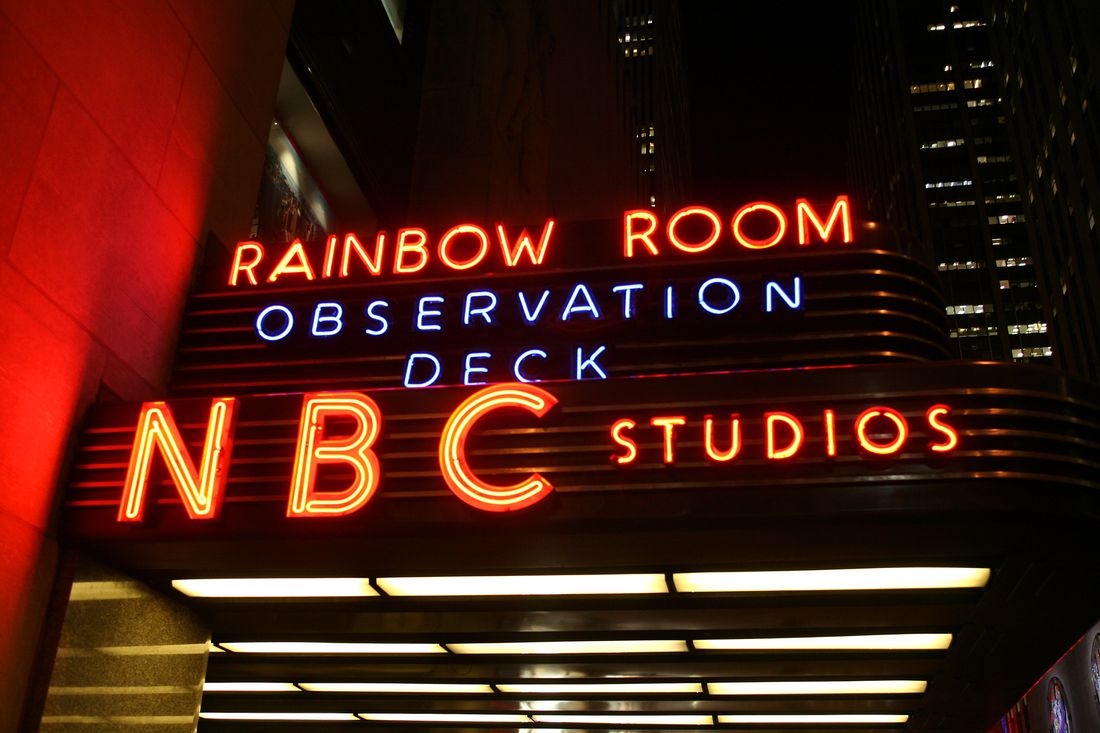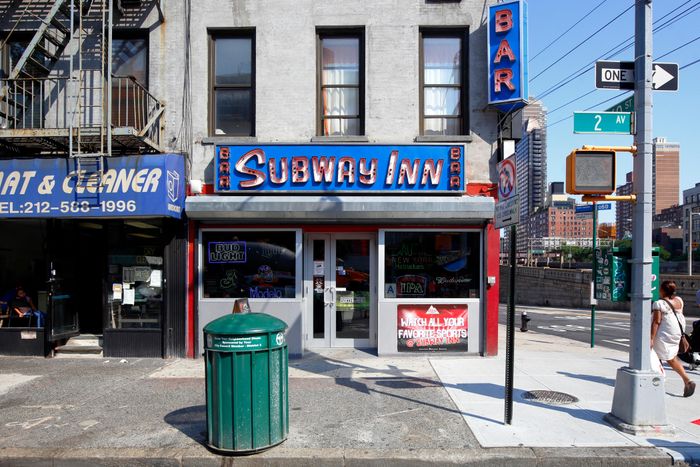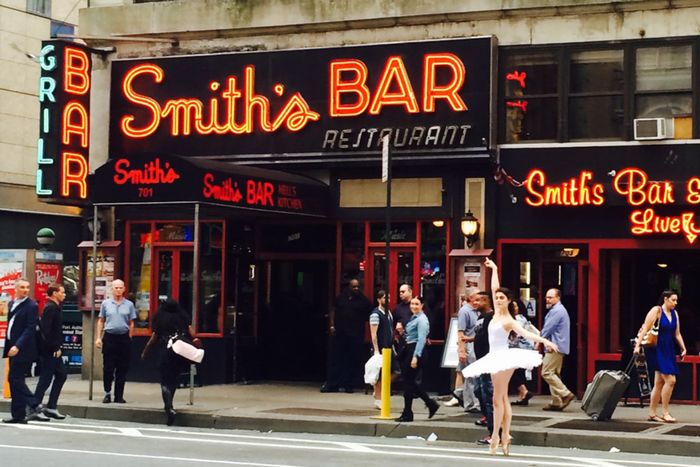
Editor’s note: On December 17, after this story was published, the Landmarks Preservation Commission voted to allow the NBC neon to be replaced with LED replicas.
The first frames in the trailer for Saturday Night, Jason Reitman’s film about the beginnings of SNL, show the side entrance to 30 Rockefeller Center, its red glowing letters spelling out NBC STUDIOS, as they have since 1935. It reminds us that we’re in Radio City, as the whole Rockefeller Center complex was known in its early decades, headquarters of the Radio Corporation of America. This place is an American monument, the source of RCA’s pioneering broadcast systems, the radio networks that in their early days were called NBC Red and NBC Blue, the ones that knitted together American thought as never before. A little later, in the TV age, these studios beamed out Toscanini and Today and Tonight. The entrance carries not just a literal neon sign but a symbolic one: power, news, late nights, modernity, the future, all beckoning.
And today, Tishman Speyer is applying to the Landmarks Preservation Commission to scrap it, replacing the glowing neon with cheaper, lower-maintenance, lower-energy LEDs.
It’s not the only neon in town that’s at risk. Great mid-century signage is going dark all over New York, especially in Manhattan. A generation or two ago, Times Square was full of glowing glassworks in every color; now there are barely any to be seen. Elsewhere in the city, a few surviving neon signs give way every year to cut-vinyl awnings, backlit fluorescent plexi, and most especially chains of single-color LEDs. Whenever an old neon-lit business like Gray’s Papaya goes out of business, the big sign is a candidate for the dumpster. That happened a few years back at Jade Mountain, an ancient chop-suey joint with signage that had hung on since the days when it faced the Third Avenue Elevated; the castoffs were rescued, badly damaged, from a literal junkyard. A few signs get saved and preserved, typically by institutions like Cincinnati’s American Sign Museum or the Neon Museum in Las Vegas, not to mention by the heroic little new not-for-profit New York Sign Museum. Those entities are labors of love, swimming against the tide, sometimes with more enthusiasm than budget or space.
Just last week, Smith’s Bar, at Eighth Avenue and 44th Street, went dark for the final time, after 70 years. The Subway Inn, which has toted its neon along through two moves after its longtime home on 60th Street gave way to a skyscraper, will be gone at the end of the year, aged 87. The neon at Papaya King, 86th Street’s “King of All Drinks,” installed in 1964, came down in 2023. (The Upper West Side bar Dublin House almost lost its enormous Celtic harp, but it was saved by a recent crowdfunding campaign and looks fantastic.) I could spend the rest of the day listing more. In fact, Thomas Rinaldi, author of the gorgeous book New York Neon, does just that on his website, and each year, it’s a long roll call of softly glowing loss.
They’re not all neighborhood bars and shops, either. Neon is being stripped away from big showplaces as well. The New Amsterdam, Disney’s back-from-ruin Broadway house on 42nd Street, quietly replaced all the Streamline Modern neon on its marquee a couple of years ago. The Apollo, on 125th Street, did the same. Those changes are less obvious than 30 Rock’s would be because most of that neon is — was — high above the street. You can’t see the little details, like the hand-twisted wires anchoring the glass tubes or the ceramic ports where they pass into the sign’s interior. Rinaldi estimates that, of the approximately 75,000 outdoor electric signs for which permits were issued between 1923 and 1956, about 130 survive, and that number is shrinking fast.


Rockefeller Center has already added a few brand-new neon-simulacrum LEDs elsewhere around the center, and they are passable if you don’t look too closely. The sign directing audience members from Sixth Avenue to Jimmy Fallon’s Tonight Show is newish and gasless.
The proposed modification to the old signage attempts to “update” the old to match the new. It’s also part of an otherwise inoffensive and reasonable change to the 30 Rock side entrances. Tishman wants to exchange the letters reading OBSERVATION DECK for TOP OF THE ROCK and to add 30 ROCKEFELLER PLAZA to the street-facing side. Those changes are unobjectionable and do not do much of anything to violate the historical fabric. (OBSERVATION DECK was added only about 20 years ago — new enough that it’s a continuity error in Reitman’s movie trailer, in fact.) That’s likely why Community Board 5’s landmarks committee greenlit this change after a hearing over the summer. The point to take issue with is not the change to the words. It’s what they’re made of. Neon, Rinaldi observes, “is an architectural material, like terra-cotta. It’s close to the sidewalk, where you see it. And it should be treated that way.”
I can already hear the response, buzzing like the blade sign at a cheap hotel: This is just a few letters over the door, barely a foot or two high. It’s not a giant like the Pepsi-Cola sign in Long Island City. Why care, why bother? Let them go. It’s a lightbulb.
Well, partly because of what it portends. Tishman Speyer owns not just 30 Rock but the rest of Rockefeller Center, and barely a hundred feet from 30 Rock stands the most dazzling example of Art Deco neon in the world. Radio City Music Hall, opened in 1932 and restored impeccably in 1999, has about six miles of glowing glass overhead, most of it in red, blue, and yellow. For a lot of the twentieth century, it was all red; the millennial restoration put back its full wild tonality, and it probably has never looked better than this. Technically, Tishman doesn’t run Radio City; the Dolans’ Madison Square Garden entertainment organization does under a long-term lease. James Dolan is the guy who built the Las Vegas Sphere. Clearly that man appreciates an LED. If Disney — which leases the New Amsterdam from New York City and State — can ditch the neon, and 30 Rock can do it, surely thoughts of a giant and destructive glass-smashing are in the air. (Editor’s note, December 20, 2024: After publication of this story, representatives of MSG told us that Radio City Music Hall’s neon has just gone through another extensive restoration, and isn’t going to be changed anytime soon.)
The rationales for the change are straightforward and twofold. No disrespect to my fellow writer Tom Scocca, but LEDs have gotten pretty great. The technology has come a long way in the past few years, and the light they emit looks vastly better than it used to. It is consistent and even. Handled well, LEDs open up new horizons in design. They are much less bulky than traditional bulbs. Their colors are true, perhaps because they are tightly restricted to narrow bands of the spectrum: The blue looks really blue, the red really red. Just recently, I wired up the bookshelves in my apartment with warm-white LED strips, and they look smashing. They also take a long time to burn out (estimates vary widely, from three years to 30, although there are issues with dimming over time), and they use a lot less energy than neon does. The application from Tishman Speyer tries to make an environmental argument — saying that the swap will decrease energy use tenfold — and even if you quibble with those numbers, they are broadly true. In a statement for this story, Tishman said as much: “The neon to LED marquee sign conversion is part of our ongoing efforts to make Rockefeller Center more energy efficient. We look forward to tomorrow’s Landmarks Preservation Commission hearing, and hope that the commissioners find the change acceptable.”
There are other environmental arguments being made in all directions, but they’re hard to reckon and easy to sling around. Certain colors of neon-style lighting contain mercury vapor (although new formulations can and do eliminate it), and that’s bad. LED manufacture requires problematic ingredients, like arsenic. Neon signs are pretty straightforwardly repairable, in part because they’re old and can be dismantled. With attention, they last for many decades, whereas LEDs are full of nonrecyclable plastics that are often glued up, and they eventually go into the e-waste bin. On the sustainability-of-materials front (and given how little actual stuff we’re talking about), it’s probably a wash.
The issue is, mostly, one of maintenance. Neon, especially old neon, is a pain in the ass. It’s expensive to make, expensive to replace. The structure of the signs is typically painted or enameled steel, and with age and weather they invariably rust, leak, and get streaky. The glass tubes are easily broken, whether by an errant toss of a ball or the corner of a box truck that backs up carelessly, and have to be replicated by hand. Making and repairing them is a not quite lost but definitely endangered craft carried out by artisans (notably at Let There Be Neon in Tribeca). The transformers that power neon lights run at extremely high voltage — up to 15,000 volts — and sometimes fry themselves to death. (LEDs typically run at 12 or 24 volts, a level so low that you can grab a bare live wire with your hand and barely feel it.) There’s a reason we associate this medium with buzzing, flickering hotel signs that say HOT L.
Rinaldi and some other neon enthusiasts offer a counterargument, saying they have done the research and the energy-usage differential is not anywhere near the level Tishman is claiming. They point out that manufacturing throwaway electronics is not particularly energy-efficient, particularly when you’re comparing that with just keeping the stuff that’s already in place. Still, on purely practical grounds, LEDs will win a lot of these fights.
What neon gives you, in return for fighting that fight, is historical continuity and distinctive beauty. Neon has a unique glow. It ever so slightly bubbles and shimmers, even when everything’s working right. There is a gradation to the light within the glass tube — brighter down the center, dimmer toward the edges — that is subtle but adds depth and dimension. The LED neon replicas don’t do that. The light they emit is flat and hard and even. Even in bright colors, it is cool. Neon, even in cool colors, is hot. It’s the difference between LP warmth and streamed audio, between Kodachrome and Blackmagic. Each is better at many things. But they are not the same. (Tishman’s proposal document includes Photoshopped before-and-after photos that show the work, and it’s clear that the after photos haven’t been messed with; they show the old parts of the signs as they are now, with real neon.) Less metaphorically speaking, it’s the difference between looking through a plastic window and a glass one. Do you have fine art in your house? Chances are good that you framed it behind glass rather than behind acrylic because glass looks better.
And much of the case for historical preservation is, fundamentally, that old materials matter. Brass and bronze, like a neon sign, have to be maintained. Perhaps, if a cornice high up on a building has long since been eliminated, it’s not tragic to reproduce it in fiberglass rather than in metal. But — and this is significant — we do not take an acetylene torch to the original bronze details on landmark buildings in order to replace them with bronze-colored plastic. LEDs can be beautiful in the right application. The argument here is that we can tear down a sign and replace it with a knockoff without seeing the difference and that they will look the same. They absolutely will not. Neon, even when it’s newer, looks like the 1930s. LEDs, no matter how fine a reproduction they are, still look like the 2020s — and, too often, like a weed shop of the 2020s.
The Landmarks Preservation Commission knows this. But its members may not be thinking about a kind of preservation we don’t hear about much, which is that of technological, rather than architectural, history. Surprisingly enough, making an ad out of glass tubes and electrified gas is not an American invention: A Frenchman, Georges Claude, got there first, and a Paris hairdresser put up the first neon business sign in 1912. But of course the American city streetscape, and then the American open road, is where the form really flourished. Tom Wolfe, in our pages in 1968, argued for it as a form of contemporary vernacular art, and so did the architects Robert Venturi and Denise Scott Brown in their hugely influential book Learning From Las Vegas. “From a cultural standpoint,” says the preservationist Theodore Grunewald, “it’s incredibly significant. That’s our argument. This is about the preservation of culture. This is Americana. It’s a national monument!” It is, and it is right over our noses, at Sixth Avenue and 49th Street.
Old technologies, before we could do so much with solid-state electronics, were different, weird, complicated. We would not today come up with a way of sharing music that depends on a tiny sapphire needle vibrating back and forth in a wavy vinyl groove. Nor would we propose a high-tech display-signage system that requires expertise in both hand-shaped glass flamework and spot-welding. Signs like this are museum pieces that are out there still doing their thing, as much as the Statue of Liberty or the Washington Monument, and they should be celebrated, not gutted.
Yes, neon is an expensive headache. It requires tending and attention; in our age, it’s pretty nearly a luxury material. But we are not asking a broke homeowner to take care of it. It’s Rockefeller Center, after all, named for its builders, by some measures the literal richest family ever. Tishman Speyer, in its recent gentle reworkings of the Center, has (apart from this one rotten idea) been both sensitive and respectful to its historical fabric. If this were an 18th-century building we were talking about, and an application to the Landmarks Preservation Commission called for removing its original fieldstone façade and replacing it with plastic blocks that look like stones, the owners would get a firm and unequivocal no. So should this.






